
Lake Baikal is a rift lake that is the deepest lake in the world. It is situated in southern Siberia, Russia between the federal subjects of Irkutsk Oblast to the northwest and the Republic of Buryatia to the southeast.

The Baikal seal, also known as Lake Baikal seal or Baikal nerpa, is a species of earless seal endemic to Lake Baikal in Siberia, Russia. Like the Caspian seal, it is related to the Arctic ringed seal. The Baikal seal is one of the smallest true seals and the only exclusively freshwater pinniped species. A subpopulation of inland harbour seals living in the Hudson Bay region of Quebec, Canada,, as well as the Saimaa ringed seal and the Ladoga seal, are also found in fresh water, but these seals are part of species that also have marine populations.
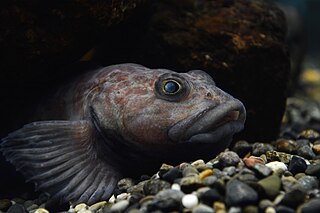
The Abyssocottinae are a subfamily of ray-finned fishes in the family Cottidae, the sculpins. They are known commonly as the deep-water sculpins. The entire subfamily is endemic to Lake Baikal in Siberia.

The slimy sculpin is a freshwater species of fish belonging to the family Cottidae, which is the largest sculpin family. They usually inhabit cold rocky streams or lakes across North America, ranging from the Great Lakes, southeast Minnesota, northeast Iowa, southwest Wisconsin and northeast Canada. Slimy sculpins have also been found roaming the cold streams of eastern Siberia. They are commonly confused with their closely related relatives, Mottled sculpin, and with tubenose gobies who are both freshwater fishes as well. The slimy sculpin is a nocturnal fish that usually spends most of its time on the stream bottom and seeks shelter under rocks and logs, especially during spawning season. When it swims, it sometimes appears to be "hopping" along the bottom because of its inefficient ability to swim. This is partly due to the absence of a swim bladder, which normally gives buoyancy to a fish.
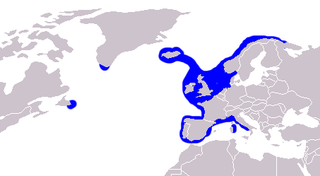
The common ling, also known as the white ling or simply the ling, is a large member of the family Lotidae, a group of cod-like fishes. It resembles the related rocklings, but it is much larger and has a single barbel. This species is unrelated to the pink ling, Genypterus blacodes, from the Southern Hemisphere. The common ling is found in the northern Atlantic, mainly off Europe, and into the Mediterranean Basin. It is an important quarry species for fisheries, especially in the northeastern Atlantic, although some doubts exist as to the sustainability of the fisheries. As an edible species, it is eaten fresh, frozen, or dried, but also preserved in lye, while the roe is a delicacy in Spain.

Comephorus, known as the golomyankas or Baikal oilfish, are a genus comprising two species of peculiar, sculpin fishes endemic to Lake Baikal in Russia. Comephorus is the only genus in the subfamily Comephorinae. Golomyankas are pelagic fishes and the main food source for the Baikal seal.
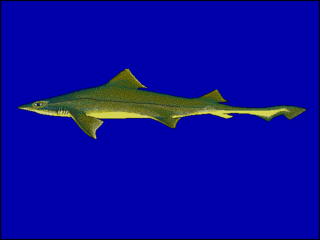
The speckled smooth-hound is a houndshark of the family Triakidae. It is found on the continental shelf of the eastern Pacific, between latitudes 0° and 54° S, at depths between 16 and 50 m. It can reach a length of 130 cm (51 in). Collectively with certain other species of shark, it is known as "tollo".
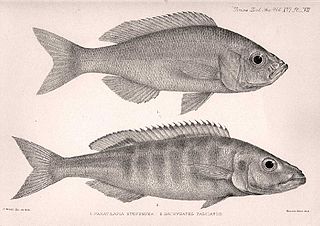
Hemibates stenosoma is a species of cichlid endemic to Lake Tanganyika in East Africa. It is generally most numerous at depths between 80 and 200 m (260–660 ft), but performs a seasonal migration to inshore regions when it can occur as shallow as 20 m (65 ft). It is predatory, feeding on fish and prawns, and grows to a total length of 30 cm (1 ft). This species was formerly regarded as the only formally described member of its genus., however, another species, Hemibates koningsi, which was formerly referred to as Hemibates sp. "stenosoma chituta" before its formal description.
The short-headed sculpin ray-finned fish belonging to the family Cottidae, the typical sculpins. This species is endemic to Lake Baikal in Russia. It lives at depths of from 400 to 1,600 metres, and is not longer than 12.2 centimetres (4.8 in) TL. This species is the only known member of its genus.
Procottus is a genus of ray-finned fish belonging to the family Cottidae, the typical sculpins. These fishes are endemic to Lake Baikal in Russia.
The Blackfin hookear sculpin is a species of marine ray-finned fish belonging to the family Cottidae, the typical sculpins. It is the only species in the monospecific genus Artediellichthys. This species is found in the northern Pacific Ocean. It occurs at depths of from 200 to 815 metres. This species grows to a total length of 13.7 cm (5.4 in).
Kessler's sculpin is a species of Baikal sculpin, a freshwater fish native to Russia and Mongolia where it occurs in Lake Baikal and surrounding lakes as well as the Selenga, Angara and Bain Gol rivers. It is the only member of its genus. In Lake Baikal it occurs on sandy, rocky-sandy or sandy-muddy bottoms, ranging from relatively shallow water to depths of 70 m (230 ft). In rivers they mainly occur in slow-flowing channels and floodplains.
The stone sculpin is a species of cottoid fish endemic to Russia, where it is found in Lake Baikal and surrounding tributaries as well as the Gramninskie Lakes, Lake Verkhnaya Agata and the Enisei River and various lakes in Tuva. This species is the only recognized member of its genus.
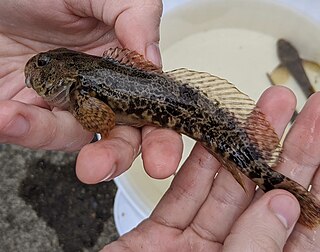
The prickly sculpin is a species of ray-finned fish belonging to the family Cottidae, the typical sculpins. It is native to the river drainages of the Pacific Slope of North America from Seward, Alaska south to the Ventura River of Southern California. It extends east of the Continental Divide in the Peace River of British Columbia. It has also been introduced to several reservoirs in Southern California.

The chiseltooth wrasse is a species of marine ray-finned fish, a wrasse from the family Labridae. It is native to the Indian Ocean and the western Pacific Ocean. It is an inhabitant of coral reefs and can be found at depths from 3 to 60 m, though rarely deeper than 40 m (130 ft). This species grows to 30 cm (12 in) in total length. It is of minor importance to local commercial fisheries and can be found in the aquarium trade. P. moluccanus is the only known member of its genus.
Procottus gotoi is a species of ray-finned fish belonging to the family Cottidae, the typical sculpins. It is endemic to Lake Baikal in Siberia. This species was first formally described in 2001 by Valentina Grigorievna Sideleva.
Procottus gurwicii, the dwarf sculpin, is a species of freshwater fish endemic to Lake Baikal in southern Siberia, Russia. It was discovered in 1946 when a single male specimen was found in the coastal waters of the lake, at a depth of about 93 metres. The specimen measured a total length of 6.2 centimetres.
Procottus jeittelesii, the red sculpin or red Baikal sculpin, is a species of ray-finned fish belonging to the family Cottidae, the typical sculpins. This species is endemic to Lake Baikal in Russia. It is a freshwater fish that dwells under stones or in holes in the mud at a depth range of 0 to 800 m. It is often found at around 100 m (330 ft), and is most abundant during the autumn and winter. From the late winter to the spring it breeds at depths of 5 to 30 m. It can reach a maximum length of 18 cm (7.1 in), but typically is 10–12 cm (3.9–4.7 in). It has a red spotted or banded pattern on a light background. The red sculpin resembles two of its close relatives, the smaller P. gurwici and the larger P. major.
The bighead sculpin is a species of sculpin fish that is endemic to the Lake Baikal watershed in Siberia, Russia. It typically lives on rocky bottoms, often in places with sponges, at depths of 5 to 70 m (16–230 ft), but can occur as deep as 120 m (390 ft). Its colour varies from grayish to brownish or greenish depending on the bottom type. It can reach up to 22 cm (8.7 in) in length, but most are 13–16 cm (5.1–6.3 in). It feeds on a wide range of smaller animals such as young fish, insect larvae, amphipods, molluscs and oligochaetes. Breeding is in the spring where the female lays 618 to 1622 eggs, which are guarded by the male.
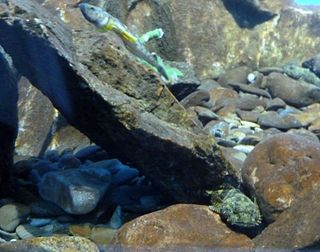
The Baikal yellowfin, also known as the yellow-finned sculpin or yellow-wing sculpin, is a species of freshwater ray-finned fish belonging to the family Cottidae, the typical sculpins. This species is endemic to Lake Baikal and its tributaries in Siberia, Russia. It is most common in the southern part of the lake and lives from near the shore to a depth of 300 m (980 ft).












